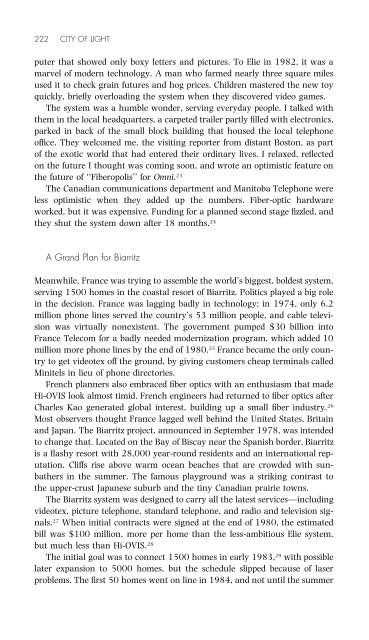City of Light: The Story of Fiber Optics
City of Light: The Story of Fiber Optics
City of Light: The Story of Fiber Optics
You also want an ePaper? Increase the reach of your titles
YUMPU automatically turns print PDFs into web optimized ePapers that Google loves.
222 CITY OF LIGHT<br />
puter that showed only boxy letters and pictures. To Elie in 1982, it was a<br />
marvel <strong>of</strong> modern technology. A man who farmed nearly three square miles<br />
used it to check grain futures and hog prices. Children mastered the new toy<br />
quickly, briefly overloading the system when they discovered video games.<br />
<strong>The</strong> system was a humble wonder, serving everyday people. I talked with<br />
them in the local headquarters, a carpeted trailer partly filled with electronics,<br />
parked in back <strong>of</strong> the small block building that housed the local telephone<br />
<strong>of</strong>fice. <strong>The</strong>y welcomed me, the visiting reporter from distant Boston, as part<br />
<strong>of</strong> the exotic world that had entered their ordinary lives. I relaxed, reflected<br />
on the future I thought was coming soon, and wrote an optimistic feature on<br />
the future <strong>of</strong> ‘‘<strong>Fiber</strong>opolis’’ for Omni. 23<br />
<strong>The</strong> Canadian communications department and Manitoba Telephone were<br />
less optimistic when they added up the numbers. <strong>Fiber</strong>-optic hardware<br />
worked, but it was expensive. Funding for a planned second stage fizzled, and<br />
they shut the system down after 18 months. 24<br />
A Grand Plan for Biarritz<br />
Meanwhile, France was trying to assemble the world’s biggest, boldest system,<br />
serving 1500 homes in the coastal resort <strong>of</strong> Biarritz. Politics played a big role<br />
in the decision. France was lagging badly in technology; in 1974, only 6.2<br />
million phone lines served the country’s 53 million people, and cable television<br />
was virtually nonexistent. <strong>The</strong> government pumped $30 billion into<br />
France Telecom for a badly needed modernization program, which added 10<br />
million more phone lines by the end <strong>of</strong> 1980. 25 France became the only country<br />
to get videotex <strong>of</strong>f the ground, by giving customers cheap terminals called<br />
Minitels in lieu <strong>of</strong> phone directories.<br />
French planners also embraced fiber optics with an enthusiasm that made<br />
Hi-OVIS look almost timid. French engineers had returned to fiber optics after<br />
Charles Kao generated global interest, building up a small fiber industry. 26<br />
Most observers thought France lagged well behind the United States, Britain<br />
and Japan. <strong>The</strong> Biarritz project, announced in September 1978, was intended<br />
to change that. Located on the Bay <strong>of</strong> Biscay near the Spanish border, Biarritz<br />
is a flashy resort with 28,000 year-round residents and an international reputation.<br />
Cliffs rise above warm ocean beaches that are crowded with sunbathers<br />
in the summer. <strong>The</strong> famous playground was a striking contrast to<br />
the upper-crust Japanese suburb and the tiny Canadian prairie towns.<br />
<strong>The</strong> Biarritz system was designed to carry all the latest services—including<br />
videotex, picture telephone, standard telephone, and radio and television signals.<br />
27 When initial contracts were signed at the end <strong>of</strong> 1980, the estimated<br />
bill was $100 million, more per home than the less-ambitious Elie system,<br />
but much less than Hi-OVIS. 28<br />
<strong>The</strong> initial goal was to connect 1500 homes in early 1983, 29 with possible<br />
later expansion to 5000 homes, but the schedule slipped because <strong>of</strong> laser<br />
problems. <strong>The</strong> first 50 homes went on line in 1984, and not until the summer

















